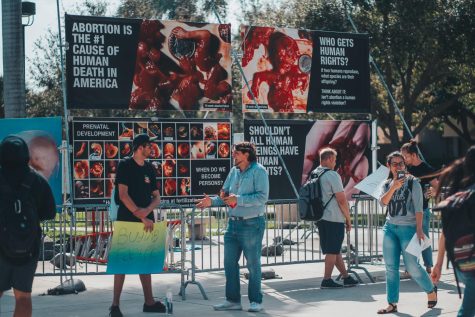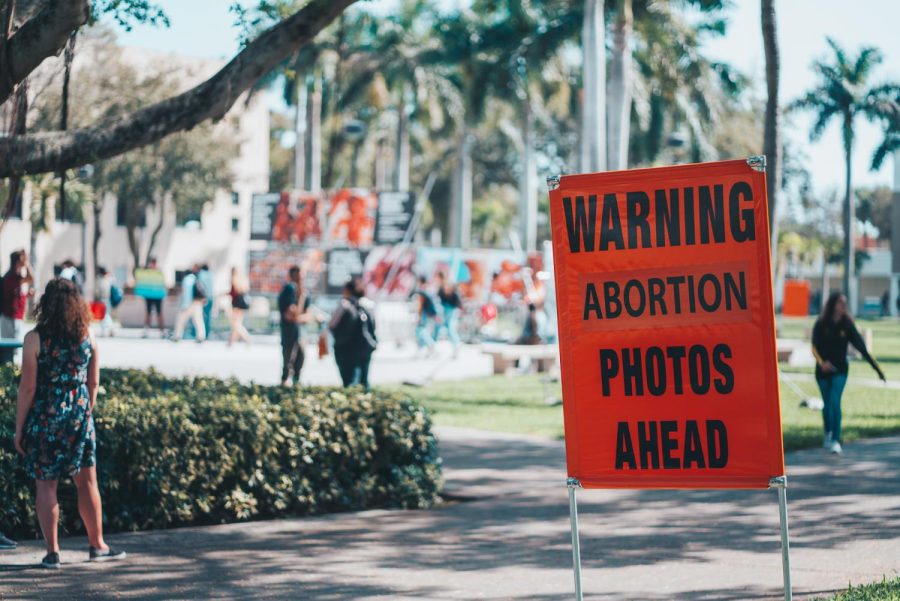University students urge for a warning in advance as a proposed alert system for anti-abortion displays was rejected in 2019
Freedom of speech policy does not require groups to notify the university of their presence.
Feb. 14, 2020, Free Speech Lawn near the Social Science Building. Warning signs were placed by members of the Canadian Center for Bio-Ethical Reform.
October 31, 2021
Content Warning: This article features graphic images that may be upsetting to some readers.
The graphic nature of past on-campus anti-abortion displays prompted a proposal for an alert system to potentially caution students about the explicit images the organizations have used to express their stance.
The pro-life organizations have expressed their message through the use of graphic visuals that depicted images of aborted fetuses covered in blood.
In 2018, Created Equal, an anti-abortion organization, arrived on the university campus to express their stance on reproductive rights. At the time, their protest not only included posters of unborn fetuses but also a JumboTron TV screen that displayed graphic abortion footage for several hours.
The next year on March 18, the Boca Raton House of Representatives passed a 25-5 resolution for FAU administration to notify students of abortion protesters’ presence on campus. The university is not required to implement Student Government resolutions.
University staff did not notify students in advance when the Canadian Center for Bio-Ethical Reform displayed posters of disembodied fetuses and protested against abortion.
“The use of graphic images by the organization was aimed to demonstrate that abortion “intentionally kills human beings,” said Cameron Côté, founder of the center.
The members of the pro-life organization also passed out pamphlets with images of bloody aborted fetuses with captions reading, “Shouldn’t All Humans Beings Have Human Rights?”
When asked about the status of the past proposal, director of student activities Donald Van Pelt explained that the Student Government resolution was vetoed by the former Student Body President Kyle MacDonald.
Because the legislation was vetoed, the resolution was not fully passed and the alert system was never instituted.
Senior art history major Sara Khambalia feels that since the university notifies students about ordinary activities, they should make students aware of the presence of the protesters.
“FAU finds a way to notify us of the most mundane activities occurring on campus. Oh great, we get to have a meet and greet with our president, as if that affects my academic life as a student. The fact that FAU fails to notify us of potentially triggering and extremely sensitive propaganda on campus is horrific. I’m not saying the images we were shown by pro-lifers isn’t factual– that really shouldn’t matter,” Khambalia said.
In 2020, the UP reported that Côté expressed that he had been intentional with the use of his graphic images.
“Throughout history, most reform movements have needed to show the victims of the injustice to demonstrate the accuracy of their cause and the importance of their cause,” he said.
Khambalia thinks use of those images could be insensitive to those who had undergone the procedure.

“The use of the images is disgusting. They’re trying to appeal to a pro-life propagated empathetic audience. It’s so sick,” she said. “No one goes into an abortion knowing that this procedure was their first choice. I knew over five peers during my undergraduate career that have had an abortion. I really [felt] so terrible for them to witness these gruesome images shown on campus.”
Junior marketing major Raya Levine explained that at the time, the images the protesters used weren’t a surprise to her.
“I wasn’t really shocked that they had those kinds of images but I was shocked at how they fully believed those images were real. There are so many different places that debunk the pictures they use but they are still using them to manipulate people. It was alarming that this what they have to do to get people on their ‘side,’ which is harmful and misleading,” Levine said.
Khambalia said without a formal warning, students did not have the choice to avoid the graphic display.
“We [didn’t] have an option in engaging in [that] media. Close friends and family of mine have had abortions. This choice was not frivolous. It was due to extenuating circumstances that made having a child a financial impossibility. If these friends and family members were subject to [those] images, I would feel so horrible for them. It’s disgusting to have to subjugate individuals to this sort of repeated trauma.”
Interim Dean of Students and Deputy Title IX Coordinator Audrey Pusey explained that the university adheres to the guidelines in Policy 4.2.2 Campus Free Speech, which does not require groups to notify the university of their presence.
“Some demonstrators do choose to post signage as part of their displays. It is not a requirement of groups to notify the university when they come to campus,” Pusey said.
Levine suggested that the university use its current alert system to notify students to avoid being exposed to the explicit anti-abortion display.
“We shouldn’t force students who don’t know they are there to be subjected to their images or them coming in their face to ‘talk.’ If they don’t want to use their own system, then make a different one for instances like this. Or even just put up signs. It is not that difficult at all,” Levine said.
Editor’s Note: This story is a part of our October/November issue titled “On Campus and Awaiting Trial,” which you can pick up on campus or read online here.
Darlene Antoine is the Features Editor for the University Press. For information regarding this or other stories, email her at antoined2019@fau.edu.








